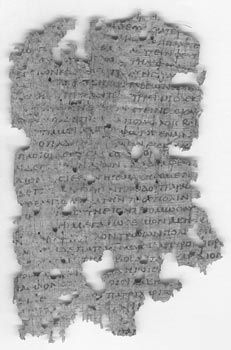
New York
, May 6, 2005The destruction of the vast majority of classical manuscripts after Christianity became the state religion was a terrible loss for Western culture. In April I was excited to learn that scholars have begun reading previously illegible papyrus fragments that include lost material from Sophocles, Euripides, Hesiod, and other important ancient authors. One report said that "Academics have hailed it as a development which could lead to a 20 per cent increase in the number of great Greek and Roman works in existence. Some are even predicting a 'second Renaissance'." Moreover, it "could easily double the surviving body of lesser work -- the pulp fiction and sitcoms of the day." [David Keys and Nicholas Pyke, The Independent, April 17, 2005.]
Scholars at Oxford University, working with researchers from Brigham Young University, are using a technology developed by NASA to photograph features in frequencies beyond the visible spectrum. The technique involves using a narrow bandwidth of infrared light that reacts with ink but not with the surrounding material, making any writing stand out more plainly and allowing photographs of formerly invisible text to be taken and read. It had already been used, in 1999, to read illegible scrolls from Herculaneum, a city buried by ash from Mt. Vesuvius in 79 CE.
The 400,000 papyrus fragments now at Oxford were discovered near the end of the 19th century in an ancient garbage dump at Oxyrhynchus in central Egypt. Decayed, worm-eaten, and blackened, they represent the world's largest cache of classical manuscripts. The material is mainly of historical interest -- codes, edicts, official correspondence, census returns, tax assessments, court records, wills, bills, inventories, horoscopes, and private letters -- but classicists were excited by new discoveries that emerged even in the first four days: mythological poetry by Hesiod and Parthenios; passages from a lost tragedy by Sophocles about the siege of Thebes (only 7 of his 120 plays survive in full); part of a novel by Lucian; unknown material by Euripides; and 30 unfamiliar lines from the Elegies of Archilochos, a 7th-century BCE successor of Homer who describes events leading up to the Trojan War (only 500 lines of his poetry had survived). Moreover, since a copy of the Gospel of Thomas was found at Oxyrhynchus, some hope that further unknown Christian and apocryphal works may turn up.
Archilochos fragment P.Oxy. LXIX 4708. © Egypt Exploration Society
The writings are mainly in Greek, but also include material in Latin, Hebrew, Coptic, Syriac, Aramaic, Arabic, Nubian, and early Persian. Dr. Dirk Obbink, who is directing the research, said that "The Oxyrhynchus collection is of unparalleled importance -- especially now that it can be read fully and relatively quickly. The material will shed light on virtually every aspect of life in Hellenistic and Roman Egypt, and, by extension, in the classical world as a whole." Digital photographs of some writings were expected to be published as early as May by the Egypt Exploration Society of London which owns the collection; documenting and preserving the fragments may require as long as a decade. -- Nicholas Vaughan
(From Sunrise magazine, June/July 2005; copyright © 2005 Theosophical University Press)